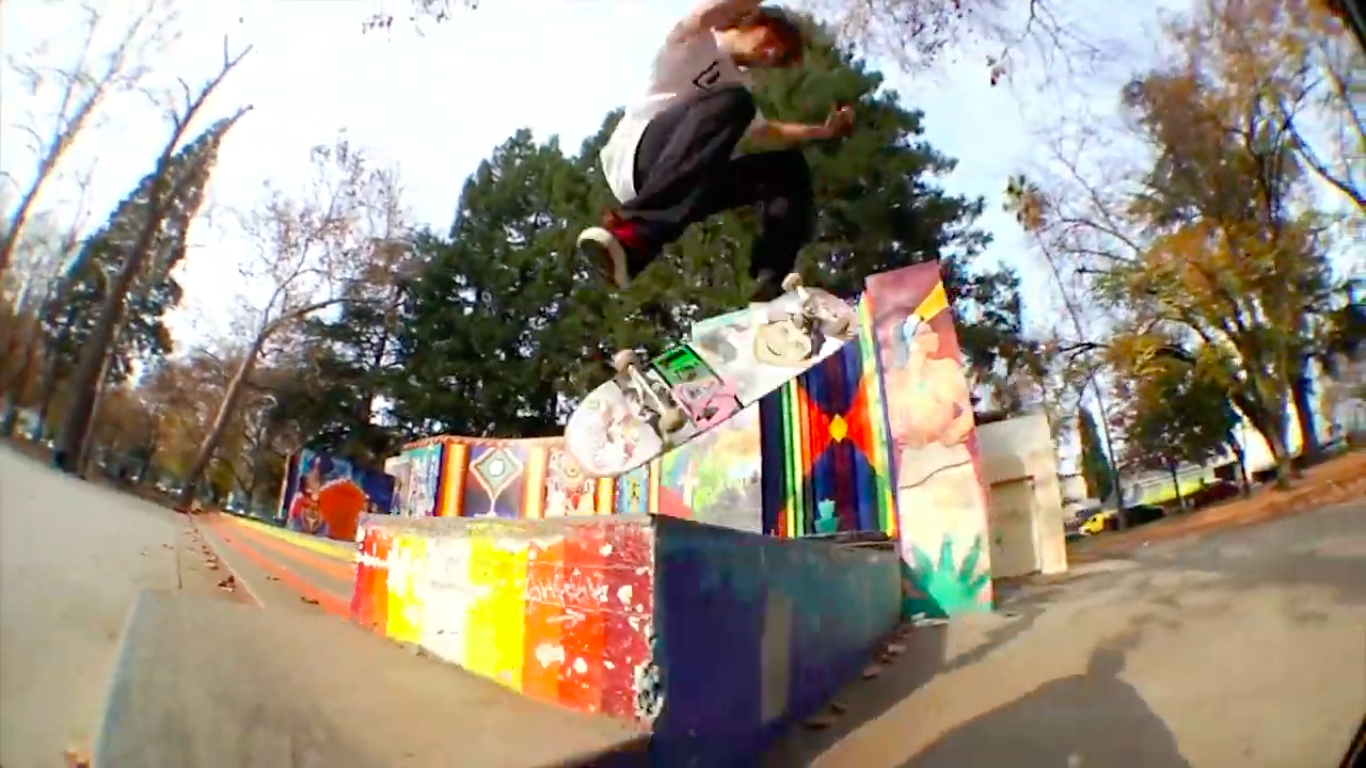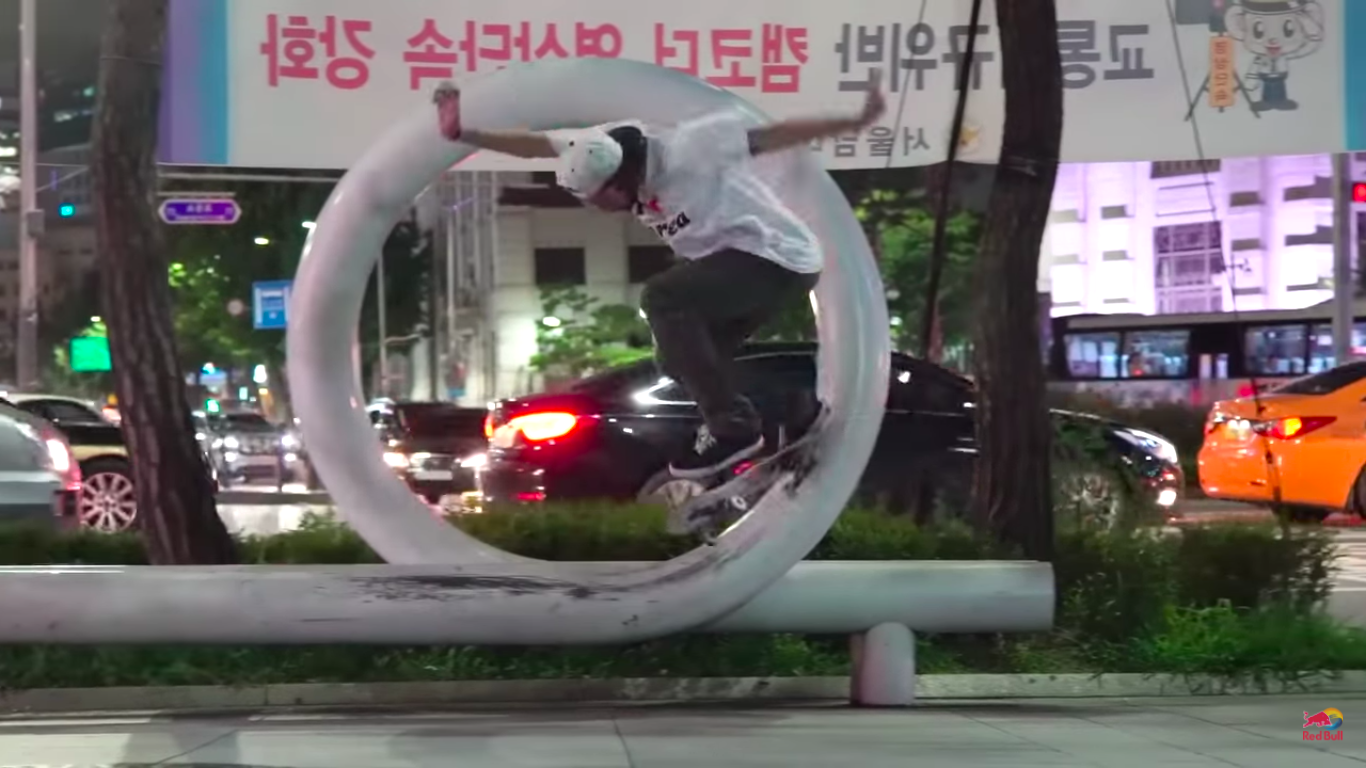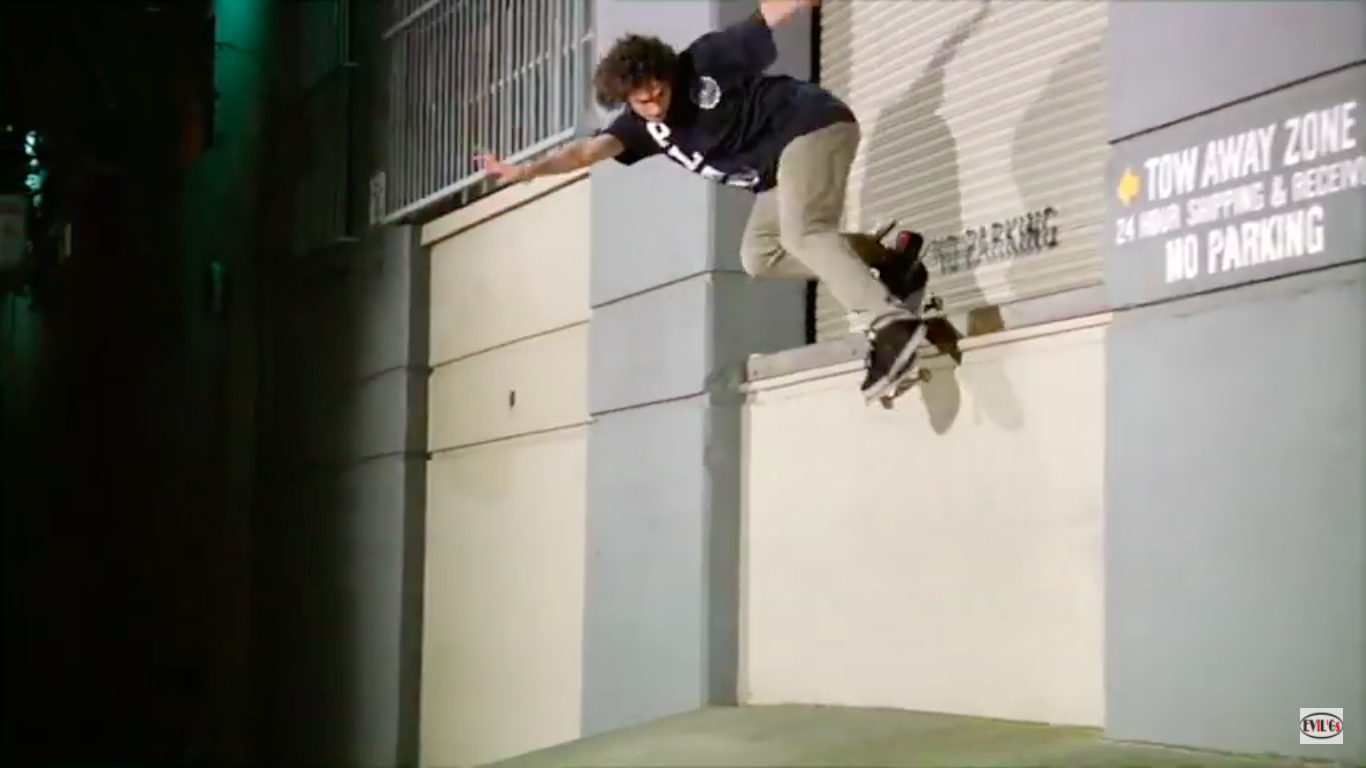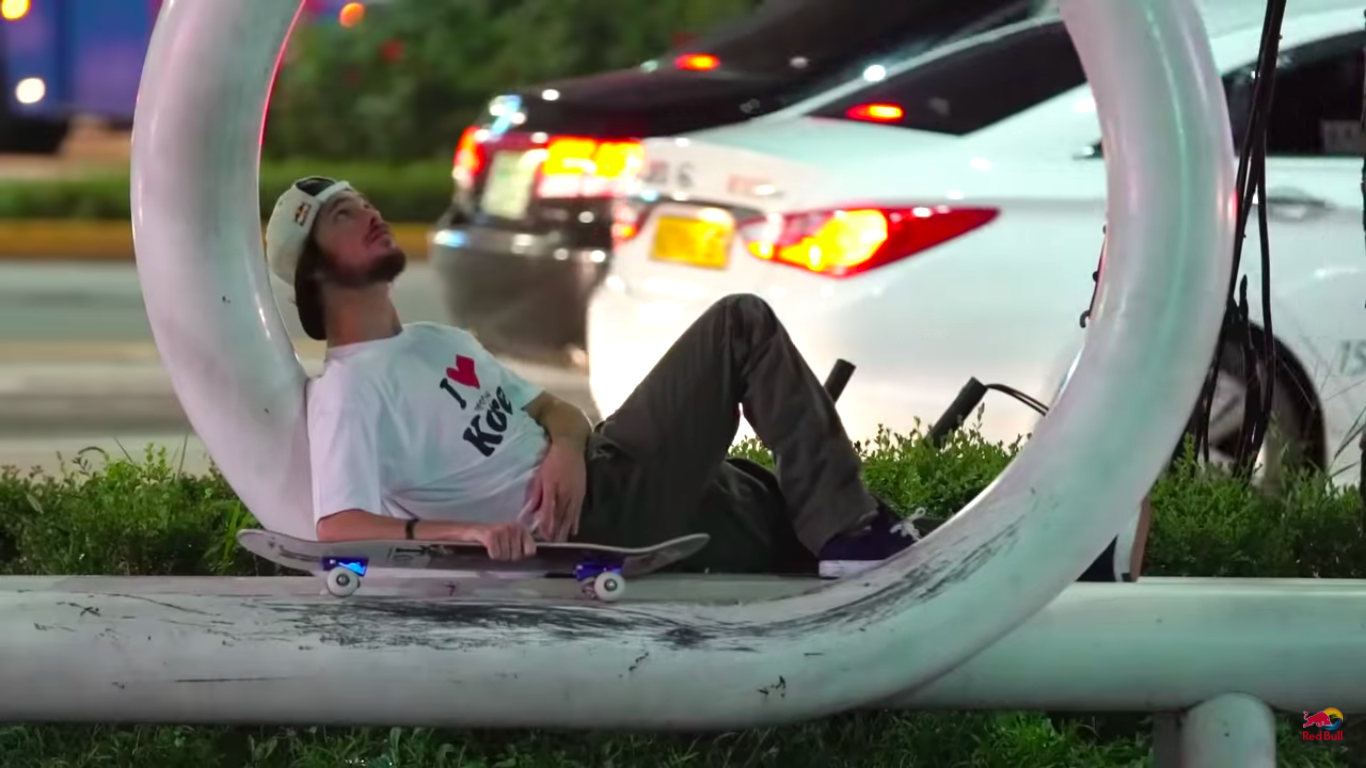How To Go Pro | Part IV: “Glyphs”
There’s always a democratic character to Pudwill’s travels, a kind of concept that he is communing with his fellow man. In his Flatbar Frenzy part, he is like Guy Fieri traveling the country in search of regional takes on comfort food, a sort of high concept low brow cooking that has perhaps always been a part of American cuisine since the industrialization of food production erased local food traditions, and replaced it with a gastronomical monoculture, but which, by the early 2000s, was regurgitated as the nation was licking it wounds, and sending its young people off to war. Clam chowder gnocchi, pepperoni pizza dip, BBQ pulled pork egg rolls, bacon BBQ brisket cheeseburger, PB&J cheeseburger, totchos (tater tot nachos), dirty taco pizza, fried cheese pizza, crab cake grilled cheese, a hot dog called “The Homewrecker,” sushi filled with cajun fries and blackened chicken, jerk chicken ravioli, pretzel chicken tenders, lasagna nachos (with fried lasagna noodles subbed for tortilla chips); and then there’s the genre of adding lobster: lobster hushpuppies, lobster mac and cheese, lobster reuben—just as Guy’s search for “awesomeness” in America’s overlooked corners has him exploring some of the most anarchic combinations of language and flavor and cultural influence, with such wild flair and common disregard for origins as to make your mind melt like griddled cheese, so too does Pudwill seek out such entertainingly gross exaggerations of common spots, plying them with a resounding, and overpowering boldness as he plumbs the depths of the American imagination, making himself a sojourner in the unfancy skate spots across the country.
We all know the common flatbar, often used to divide two neighboring parking lots, or as a phalanx of steel tubing to prevent cars from hitting the wall of a building—the kind of thing you’ve seen at the midcentury ranch home your dentist uses for her dental practice—but Pudwill’s approach here has lost all site of the original meaning of this familiar object, has entirely distanced himself from all sense of proportion, entering into a space of pure image and imagination. It is as unctuous, belabored, and outright strange as anything Fieri eats on his show (or concocts for his chain of restaurants) to watch our skateboarding everyman backside lipslide a log in some national park’s parking lot, or for him to ollie over a bike to skate one, or to haul a stranded piece of metal tubing out to the salt flats and skate it at the golden hour.
We all know the common flatbar, often used to divide two neighboring parking lots, or as a phalanx of steel tubing to prevent cars from hitting the wall of a building—the kind of thing you’ve seen at the midcentury ranch home your dentist uses for her dental practice—but Pudwill’s approach here has lost all site of the original meaning of this familiar object, has entirely distanced himself from all sense of proportion, entering into a space of pure image and imagination. It is as unctuous, belabored, and outright strange as anything Fieri eats on his show (or concocts for his chain of restaurants) to watch our skateboarding everyman backside lipslide a log in some national park’s parking lot, or for him to ollie over a bike to skate one, or to haul a stranded piece of metal tubing out to the salt flats and skate it at the golden hour.
And there is a truly strange feeling, as if he were skating in an architectural rendering, when he mounts himself to the cornice of some peculiar foreign bench, its backrest formed of polished chrome metal tubing twisted into the cool, non-linear ergonomics that only an algorithm could calculate. An image of an image of an image, with his skating, too, gaining some exaggerated girth—higher, longer, more flip tricks, more complex combinations, so that it almost gets to be more solid, girthy, a two hander were it some kind of cheeseburger.
One reading of Pudwill’s antics, and, really, for his career overall, presents itself in the rhetorical position that he is just skating, with the beauty of his style making an appeal to the simple pleasures of spectacle. The guy is clearly just having fun, and based on all the day in the life content, we also know that he takes it seriously, but not too seriously. That, even if his skating is not your favorite, he’s still one of the good guys. A skater through and through. Yet, there is still something profane that comes through in Flatbar Frenzy, particularly in the instance in which it seems like Pudwill is no longer inhabiting a space built for people, pinching a backside tailslide onto the thick, enamel-coated metal tubing of what appears to be a sculpture from Carol Bove’s “Glyphs” series (2013-present).
One reading of Pudwill’s antics, and, really, for his career overall, presents itself in the rhetorical position that he is just skating, with the beauty of his style making an appeal to the simple pleasures of spectacle. The guy is clearly just having fun, and based on all the day in the life content, we also know that he takes it seriously, but not too seriously. That, even if his skating is not your favorite, he’s still one of the good guys. A skater through and through. Yet, there is still something profane that comes through in Flatbar Frenzy, particularly in the instance in which it seems like Pudwill is no longer inhabiting a space built for people, pinching a backside tailslide onto the thick, enamel-coated metal tubing of what appears to be a sculpture from Carol Bove’s “Glyphs” series (2013-present).
An unusual body of work, these massive metal sculptures twist, spiral, and all around warp their hulking industrial substrate into evocative sci-fi line drawings in space that evoke an alien symbology, a sort of free standing hieroglyph, but whose polished white surfaces reveal little of the origins of that meaning, or the intent behind what they seek to communicate—to some extent, fulfilling the promise of modernism by using contemporary technologies and materials to produce something that verges on pure art, pure surface, pure design. Alluring, but inscrutable. Spiritual, but also technologically secular. A bold evocation of the minimalist doctrine of presence, that nonetheless abides soft edges and a vague nod toward the figurative image, albeit abstract. To see Pudwill contemplate this sophisticated object, both in a trick, and in a brief image of him sitting within its mysterious contours, is to see him reach for the profound, reach for something beyond speech or easy meaning, beyond even the supposed truth and facticity of his own transparency.
Obviously, it also just looks fun to skate, its contours making for a poignant addition to his menagerie of pedestrian distortions. But the gesture also offers a poignant image of a time when a thirst for luxury seemed almost insatiable, with the layman availing himself of art to dress up the background of a simple social media post without having to shell out money on the real thing, money they did not, nor would they ever really possess. Museums catering to the types of immersive installations millennials and zoomers craved fed into the clout machine, and boasted record numbers. But the trade off was that they fundamentally changed the value of this specialized category, on the one hand democratizing it, making it available to the masses, while also decontextualizing it, perhaps even rendering it meaningless beyond its ability to spruce up a selfie. Effectively, making it interesting at best. Whether art was being consumed on its own terms was besides the point. The ambivalence to which art was met and used online cynically fulfilled a notion from modern art’s founding father, Marcel Duchamp, who said that everyone was an artist, though in recent years, that prophecy could be fulfilled with a selfie.
Obviously, it also just looks fun to skate, its contours making for a poignant addition to his menagerie of pedestrian distortions. But the gesture also offers a poignant image of a time when a thirst for luxury seemed almost insatiable, with the layman availing himself of art to dress up the background of a simple social media post without having to shell out money on the real thing, money they did not, nor would they ever really possess. Museums catering to the types of immersive installations millennials and zoomers craved fed into the clout machine, and boasted record numbers. But the trade off was that they fundamentally changed the value of this specialized category, on the one hand democratizing it, making it available to the masses, while also decontextualizing it, perhaps even rendering it meaningless beyond its ability to spruce up a selfie. Effectively, making it interesting at best. Whether art was being consumed on its own terms was besides the point. The ambivalence to which art was met and used online cynically fulfilled a notion from modern art’s founding father, Marcel Duchamp, who said that everyone was an artist, though in recent years, that prophecy could be fulfilled with a selfie.
It then makes sense that images of art would begin to appear in Pudwill’s skate parts. To see our everyman contemplate the sculpture, it can be easy to lose track of which one takes place in the real world. There’s almost a field of distortion that emerges. He’s actually interacting with it, thrusting the last bit of his balance through the bend of the corkscrew’s initial contours, landing fakie as if to mirror the sculpture’s formal inversion. But one wonders whether this is simply one illusion mirroring another. The sculpture’s aesthetic polish and its elegant symbolism, its high mindedness and idealism, are met with a skater that upholds a certain ideal of what a professional can be, albeit an idealism that similarly speaks in a kind of frozen set of glyphs and secular, subcultural piety. Just as the sculpture spins Pudwill around, we are right back where we started, an ambivalent picture of a dreamer trying to make his ambitions real in an unreal world. Here is Pudwill in all his glory, demonstrating yet again how to go pro. •••



